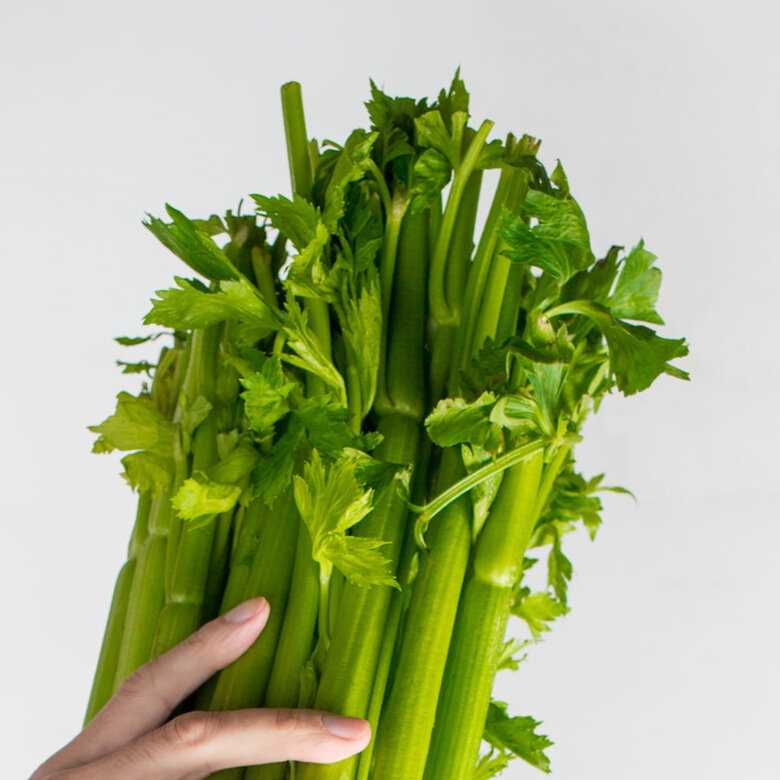- Benefits of Growing Celery at Home
- Key Factors to Consider when Choosing Celery Seeds
- Variety
- Open-Pollinated vs. Hybrid Seeds
- Purchasing Seeds
- Germination Rate
- Storage
- Availability
- Best Soil and Potting Mix for Growing Celery
- 1. Loamy Soil
- 2. Organic Matter
- 3. pH Levels
- 4. Drainage
- 5. Nutrients
- 6. Potting Mix for Containers
- 7. Mulching
- Watering and Fertilizing Tips for Successful Celery Growth
- Watering
- Fertilizing
- Providing Optimal Lighting Conditions for Celery
- 1. Location
- 2. Orientation
- 3. Window Coverings
- 4. Supplemental Lighting
- 5. Light Duration
- 6. Light Quality
- Controlling Pests and Diseases in Celery Plants
- 1. Pest Prevention:
- 2. Common Pests:
- 3. Disease Prevention:
- 4. Common Diseases:
- 5. Organic and Chemical Controls:
- Harvesting and Storing Your Homegrown Celery
- 1. Timing:
- 2. Cutting:
- 3. Washing:
- 4. Storing:
- 5. Using:
- “Question-Answer”
- Can I grow celery on a windowsill?
- What are the key factors to consider when choosing a root crop to grow on a windowsill?
- How much sunlight does celery need to grow on a windowsill?
- What is the ideal root depth for growing celery on a windowsill?
- How big do celery plants get when fully grown?
- “Video” The Secret to Growing Tasty Celery || Black Gumbo
When it comes to growing celery on a windowsill, there are a few key factors to consider in order to achieve success. Celery, a root crop, can be a rewarding plant to grow indoors, especially if you have limited gardening space or live in a climate where outdoor gardening is not possible year-round. By selecting the right variety, providing the proper growing conditions, and following some essential tips, you can enjoy fresh, homegrown celery right from your own windowsill.
One important factor to consider when choosing a root crop like celery for indoor cultivation is the variety that you select. Some varieties of celery are better suited for indoor growing, as they have been specifically bred to thrive in containers and limited space. Look for compact or dwarf varieties that will fit well on a windowsill and have a shorter maturity time. These varieties will often require less space, less sunlight, and less time to reach harvest.
Another crucial factor to consider is the growing conditions you provide for your indoor celery plant. Celery thrives in a consistently moist environment with plenty of sunlight. It is important to choose a location for your windowsill garden that receives at least 6-8 hours of direct sunlight per day. Additionally, make sure to provide regular watering to keep the soil moist, but not waterlogged. Using a well-draining potting mix and incorporating organic matter can help ensure optimal growth.
Lastly, it is important to follow some essential tips to maximize the success of your indoor celery garden. Start by germinating the celery seeds indoors before transplanting them to the windowsill. This will give the plants a head start and increase their chances of survival. Additionally, provide proper support for the celery plants as they grow, as they can become top-heavy and prone to tipping over. This can be done by using stakes or plant cages to support the stems.
In conclusion, growing celery on a windowsill can be a rewarding experience if you consider the key factors mentioned above. By selecting the right variety, providing the proper growing conditions, and following essential tips, you can enjoy the taste of fresh, homegrown celery throughout the year. Whether you have limited gardening space or simply enjoy the convenience of growing vegetables indoors, celery is a great root crop choice for your windowsill garden.
Benefits of Growing Celery at Home
Growing celery at home offers several benefits, including:
- Control over growing conditions: When growing celery at home, you have complete control over the growing conditions. You can choose organic seeds and avoid using chemicals or pesticides, ensuring that you have a healthy and toxin-free plant.
- Cost savings: Celery can be quite expensive to buy, especially if you opt for organic varieties. By growing celery at home, you can save money by harvesting your own fresh and organic celery.
- Fresh and flavorful produce: Celery that is grown and harvested at home tends to be much fresher and more flavorful than store-bought varieties. You can enjoy the crisp, juicy taste of homegrown celery in your favorite dishes.
- Year-round availability: By growing celery indoors on a windowsill, you can enjoy fresh celery year-round, regardless of the season. This means you can always have this nutritious vegetable on hand for your recipes and snacks.
- Controlled pesticide exposure: When growing celery at home, you have the power to control the use of pesticides. This is especially important if you are concerned about the potential health risks associated with conventional pesticide use on commercially grown vegetables.
- Satisfaction and sense of accomplishment: Growing your own celery can be a rewarding experience. Watching the plants sprout, grow, and produce edible stalks gives you a sense of accomplishment and satisfaction that comes with successfully cultivating your own food.
Overall, growing celery at home allows you to have a sustainable source of fresh, organic, and delicious celery while also giving you the opportunity to experiment with different growing techniques and varieties.
Key Factors to Consider when Choosing Celery Seeds
When it comes to growing celery on a windowsill or any other space, choosing the right seeds is crucial for a successful harvest. Here are some key factors to consider when selecting celery seeds:
Variety
There are different varieties of celery, each with its own unique characteristics. Consider your personal preferences and needs when selecting a variety. Some common celery varieties include:
- Standard green celery: This is the most common variety, known for its crisp texture and strong flavor.
- Golden yellow celery: This variety has a milder taste and a vibrant yellow color.
- Red celery: This variety adds a pop of color to dishes and has a slightly stronger flavor compared to standard green celery.
Open-Pollinated vs. Hybrid Seeds
Open-pollinated seeds are seeds that are pollinated naturally by wind, insects, or other natural means. They produce plants with traits that closely resemble the parent plant. Hybrid seeds, on the other hand, are created by cross-pollinating two different varieties to produce plants with specific desired traits. Consider whether you prefer to grow open-pollinated or hybrid celery plants.
Purchasing Seeds
When purchasing celery seeds, consider the following factors:
- Freshness: Look for seeds that are labeled as fresh or for the current growing season.
- Quality: Choose seeds from reputable seed companies to ensure quality and reliability.
- Organic: If you prefer to grow organic celery, look for organic-certified seeds.
Germination Rate

Check the germination rate of the seeds you are considering. High-quality seeds will have a higher germination rate, which means a greater chance of successful growth.
Storage
Proper storage of celery seeds is important to maintain their viability. Store seeds in a cool, dry place away from direct sunlight. Consider using airtight containers or resealable bags to keep them fresh for future use.
Availability
Depending on your location, certain celery seed varieties may be more readily available than others. Consider what is easily accessible to you when making your selection.
By considering these key factors when choosing celery seeds, you can ensure a successful and rewarding growing experience on your windowsill or any other space.
Best Soil and Potting Mix for Growing Celery

Growing celery requires a specific type of soil and potting mix to ensure optimal growth and a bountiful harvest. The right soil composition provides the necessary nutrients and drainage for celery plants to thrive. Here are some key factors to consider when choosing the best soil and potting mix for growing celery:
1. Loamy Soil

Celery plants prefer loamy soil, which is a balanced combination of sand, silt, and clay. Loamy soil is well-draining, retains moisture, and provides a good balance of nutrients. Avoid heavy clay soils or sandy soils that drain too quickly.
2. Organic Matter
Adding organic matter to the soil is crucial for growing healthy celery. This can be achieved by incorporating well-rotted compost, aged manure, or leaf mold into the soil. Organic matter improves soil structure, enhances moisture retention, and provides essential nutrients.
3. pH Levels
The ideal pH level for celery plants is between 6.0 and 7.0. Test the soil’s pH using a testing kit and adjust it if necessary. If the pH is too low (acidic), add lime to raise it. If it’s too high (alkaline), add sulfur or peat moss to lower it to the preferred range.
4. Drainage
Proper drainage is essential for celery plants as they can’t tolerate waterlogged soil. Ensure the soil has good drainage by adding organic matter or perlite to improve aeration and prevent water from stagnating around the roots.
5. Nutrients
Celery plants are heavy feeders and require a rich source of nutrients to grow effectively. Prior to planting, incorporate a balanced fertilizer or slow-release organic fertilizer into the soil to provide essential nutrients such as nitrogen, phosphorus, and potassium.
6. Potting Mix for Containers
If growing celery in containers, use a high-quality potting mix formulated for vegetables. Look for a mix that contains a blend of peat moss, perlite, vermiculite, and compost. This type of mix provides good drainage, aeration, and a rich source of nutrients.
7. Mulching
Adding a layer of organic mulch around celery plants helps conserve moisture, suppress weeds, and maintain a more consistent soil temperature. Organic mulch options include straw, grass clippings, or chopped leaves. Apply a 2-3 inch layer around the base of the plants, keeping it a few inches away from the stems to prevent rotting.
By selecting the right soil and potting mix, you can give your celery plants the best possible conditions for growth and ensure a successful harvest of fresh, crunchy stalks.
Watering and Fertilizing Tips for Successful Celery Growth
Proper watering and fertilizing are essential for successful celery growth. The following tips will help you ensure your celery plants receive the right amount of water and nutrients to thrive:
Watering
- Keep the soil consistently moist but not waterlogged. Celery plants require regular watering to ensure adequate growth.
- Water deeply, ensuring the soil is thoroughly soaked. Shallow watering can result in shallow root development and weak plants.
- Water celery plants early in the morning or late in the evening to minimize evaporation and to allow leaves to dry before nightfall, reducing the risk of disease.
- Use a soaker hose or drip irrigation system to deliver water directly to the roots, avoiding wetting the leaves, which can lead to fungal diseases.
- Monitor the moisture level of the soil regularly, especially during hot and dry periods, and adjust watering accordingly.
Fertilizing
- Before planting celery, incorporate well-rotted compost or organic matter into the soil to provide nutrients.
- Apply a balanced fertilizer, such as a 10-10-10 or 14-14-14 blend, once or twice during the growing season. Follow the manufacturer’s instructions for application rates.
- Apply fertilizer evenly around each plant, keeping it at least a few inches away from the base of the stems to prevent burning the plants.
- Avoid excessive nitrogen fertilization, as it can result in lush foliage growth at the expense of root development.
- Consider using organic fertilizers, such as fish emulsion or seaweed extract, for a more natural approach to feeding your celery plants.
By following these watering and fertilizing tips, you can provide your celery plants with the proper care they need to grow and thrive on your windowsill.
Providing Optimal Lighting Conditions for Celery
Celery is a root crop that requires a significant amount of light to grow successfully. When growing celery on a windowsill, it is important to provide optimal lighting conditions to ensure the health and growth of the plant.
1. Location
Choose a windowsill that receives at least 6-8 hours of direct sunlight each day. Celery plants thrive in full sun, so it is important to select a windowsill that gets ample sunlight throughout the day.
2. Orientation

Place the celery plants on a windowsill that faces south or west. These orientations typically receive the most sunlight during the day, allowing for maximum exposure to natural light.
3. Window Coverings
Avoid using heavy curtains or blinds that block the sunlight. Instead, opt for sheer or light-colored curtains that will provide some shade without reducing the amount of light that reaches the celery plants. If necessary, remove any window coverings during the hours of direct sunlight to ensure the plants receive maximum light.
4. Supplemental Lighting
If your windowsill does not receive enough natural light, consider using supplemental lighting to provide the necessary light for celery plants. LED grow lights can be used to supplement or replace natural light and ensure the plants receive the right amount of light for optimal growth.
5. Light Duration
Celery plants require a minimum of 6-8 hours of direct sunlight each day. Ensure that the plants receive this amount of light by monitoring the duration of sunlight they receive. If necessary, adjust their position on the windowsill or use timers to simulate the required amount of light.
6. Light Quality

The quality of light is as important as the duration. Natural sunlight provides a full spectrum of light necessary for plant growth. If using supplemental lighting, choose LED grow lights that mimic the full spectrum of sunlight. This will provide the plants with the necessary wavelengths required for photosynthesis.
By providing optimal lighting conditions for celery plants on a windowsill, you can ensure their health and promote successful growth. Remember to monitor the duration and quality of light and make any necessary adjustments to provide the best possible lighting conditions for your celery plants.
Controlling Pests and Diseases in Celery Plants
When growing celery on a windowsill, it is important to take steps to prevent and control pests and diseases. Here are some key tips to keep your celery plants healthy:
1. Pest Prevention:
- Cleanliness: Regularly clean the windowsill and surrounding area to remove any debris or potential hiding places for pests.
- Inspect: Regularly inspect your celery plants for signs of pests such as aphids, caterpillars, or mites. Remove any affected leaves or plants immediately.
- Companion planting: Planting celery alongside pest-repelling plants such as garlic, onions, or marigolds can help deter pests.
2. Common Pests:
- Aphids: These small, green insects can suck the sap from celery plants. Use insecticidal soap or spray them off with water.
- Caterpillars: These larvae can eat through celery leaves. Handpick them off or use organic pesticides specifically labeled for caterpillar control.
- Mites: These tiny pests can cause yellowing and stunted growth. Use a miticide or insecticidal soap to control them.
3. Disease Prevention:
- Start with healthy plants: Purchase or start with healthy celery plants to reduce the risk of diseases.
- Air circulation: Ensure good air circulation around your celery plants by spacing them properly and avoiding overcrowding.
- Watering: Avoid overhead watering, as it can promote fungal diseases. Water at the base of the plants and keep the leaves dry.
4. Common Diseases:
- Leaf blight: This fungal disease causes brown spots on leaves. Remove and destroy affected leaves, and use a fungicide if necessary.
- Blackheart: This physiological disorder causes blackened stems and leaf stalks. Prevent by providing consistent moisture and avoiding excessive heat or fluctuations in temperature.
- Rust: This fungal disease causes orange or brown spores on leaves. Remove and destroy infected leaves, and use a fungicide if necessary.
5. Organic and Chemical Controls:

When controlling pests and diseases, consider using organic methods first. Organic options include insecticidal soaps, neem oil, and beneficial insects such as ladybugs or lacewings. If the infestation or disease persists, you may need to resort to chemical controls. Always follow the instructions on the product label and consider the effects on beneficial insects and the environment.
By implementing these pest and disease control measures, you can enjoy healthy and thriving celery plants on your windowsill.
Harvesting and Storing Your Homegrown Celery
Once your celery plants have reached maturity and are ready to be harvested, follow these tips to ensure a successful harvest and storage:
1. Timing:
Harvest your celery when the stalks are at least 8-10 inches long and the leaves are dark green. Avoid harvesting too early as immature celery may not have developed its full flavor.
2. Cutting:
Cut the celery stalks at the base using a sharp knife or garden shears. Make a clean cut just above the soil level, being careful not to damage any neighboring plants.
3. Washing:
After harvesting, gently wash the celery stalks to remove any dirt or debris. Use cool running water and pat them dry with a clean towel or paper towel.
4. Storing:
There are several methods you can use to store your homegrown celery:
- Refrigerator: Place the celery stalks in a ziplock bag or wrap them in a damp paper towel. Store them in the vegetable crisper drawer of your refrigerator. Celery can usually be kept in the fridge for up to 2 weeks.
- Freezing: Chop the celery stalks into small pieces and blanch them in boiling water for 2-3 minutes. After blanching, transfer the celery to an ice bath to cool it down. Drain the celery and pat it dry before placing it in freezer-safe bags or containers. Frozen celery can be stored for up to 1 year.
- Dehydrating: Slice the celery stalks into thin pieces and dehydrate them using a food dehydrator or an oven set to a low temperature. Once fully dehydrated, store the celery in an airtight container in a cool, dark place. Dehydrated celery can last for several months or even longer.
- Canning: If you have experience with canning, you can preserve your celery by canning it in jars. Follow proper canning procedures and guidelines to ensure safe storage.
5. Using:

Your homegrown celery can now be used in a variety of delicious recipes. Enjoy it raw in salads, use it as a crunchy snack with dip, add it to soups, stews, or stir-fries, or juice it for a nutritious drink. The possibilities are endless!
By following these tips for harvesting and storing your homegrown celery, you can enjoy the fruits of your labor for an extended period and savor the taste of freshly harvested celery all year round.
“Question-Answer”
Can I grow celery on a windowsill?
Yes, you can grow celery on a windowsill as long as it receives at least 6 hours of direct sunlight per day.
What are the key factors to consider when choosing a root crop to grow on a windowsill?
The key factors to consider when choosing a root crop to grow on a windowsill are the amount of sunlight the crop requires, the size of the plants when fully grown, and the root depth that the plants need.
How much sunlight does celery need to grow on a windowsill?
Celery needs at least 6 hours of direct sunlight per day to grow on a windowsill. If your windowsill does not receive enough sunlight, you can also use grow lights to supplement the light.
What is the ideal root depth for growing celery on a windowsill?
The ideal root depth for growing celery on a windowsill is at least 8 to 10 inches. Celery has long, fibrous roots that require enough space to grow and develop properly.
How big do celery plants get when fully grown?
Celery plants can grow to be around 18 to 24 inches tall when fully grown. It’s important to choose a variety of celery that will not outgrow your windowsill and have enough space to accommodate the full size of the plants.







